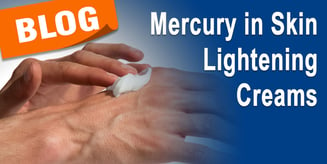 Mercury is well known to international agencies as toxic and a risk to human health. And yet, mercury is a common ingredient in cosmetic skin whitening creams due to its bleaching effect on skin. Repeated topical application can cause mercury to accumulate in the body as it is easily absorbed through the skin as well as through the lungs by inhalation. Applying these creams repeatedly and for prolonged periods of time can cause numerous adverse health effects. Mercury is still being added as an ingredient despite the known health concerns associated with it.
Mercury is well known to international agencies as toxic and a risk to human health. And yet, mercury is a common ingredient in cosmetic skin whitening creams due to its bleaching effect on skin. Repeated topical application can cause mercury to accumulate in the body as it is easily absorbed through the skin as well as through the lungs by inhalation. Applying these creams repeatedly and for prolonged periods of time can cause numerous adverse health effects. Mercury is still being added as an ingredient despite the known health concerns associated with it.
A recent report by the Zero Mercury Working Group (ZMWG) found there are cosmetic skin lightening creams being sold online that contain unacceptable levels of mercury. In the ZMWG study, skin bleaching products were obtained from 17 countries all over the world and analyzed for mercury by X-ray Fluorescence Spectrometry and Combustion Atomic Absorption Spectroscopy. Of the 271 samples collected, 129 had high levels of mercury. That’s 47% of products tested. Multiple samples had mercury levels tens of thousands of times higher than the acceptable limit.
The Food and Drug Administration (FDA) and Minamata Convention on Mercury both set limits of 1 part per million (ppm) of mercury for cosmetics including skin lightening creams. The Minamata convention also prohibits the manufacture, import, and export of products exceeding the 1ppm limit. But these products are being sold by third party retailers on large commercial sites like eBay, Amazon, and Aliexpress. These larger companies all have policies stating the sale of illegal products is prohibited and sellers are expected to follow regulations and company policies.
The best way to keep these inexpensive and toxic products off large retail sites is to report the products to the site, have them removed, and the sellers banned. The retail sites hold the position that the individual third-party sellers are responsible for the health and safety compliance of the products sold rather than the platforms themselves. Consumers can protect themselves by purchasing products with ingredients listed on the packaging which is required by the FDA. Some ingredients to avoid include words like ‘calomel’, ‘mercurous chloride’, or ‘mercuric iodide’. It’s important for consumers and sellers to know about the dangers of possible mercury toxicity associated with the use of these skin products.
For more information on Mercury Analysis, please contact us
- https://www.cnn.com/2022/03/09/world/zmwg-skin-whitening-creams-mercury-ecommerce-sites-intl-cmd/index.html
- https://www.fda.gov/consumers/health-fraud-scams/skin-products-containing-mercury
- https://www.fda.gov/consumers/consumer-updates/mercury-poisoning-linked-skin-products
- https://www.ecfr.gov/current/title-21/chapter-I/subchapter-G/part-700/subpart-B/section-700.13
- https://www.mercuryconvention.org/en/about
- https://www.mercuryconvention.org/sites/default/files/documents/information_document/Minamata-Convention-booklet-Sep2019-EN.pdf
- https://eeb.org/library/mercury-added-skin-lightening-creams-available-inexpensive-and-toxic/
- https://eeb.org/wp-content/uploads/2020/02/zmwg_skin_lightening_cream_report_final_nov_20181.pdf

